RAF Coningsby
| RAF Coningsby | |||||||
|---|---|---|---|---|---|---|---|
| NearConingsby,Lincolnshirein England | |||||||
 AEurofighter Typhoontakes off from RAF Coningsby. | |||||||
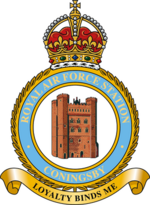 Loyalty binds me[1] | |||||||
| Coordinates | 53°05′35″N000°09′58″W/ 53.09306°N 0.16611°W | ||||||
| Type | Main Operating Base | ||||||
| Area | 420 hectares (1,000 acres)[2] | ||||||
| Site information | |||||||
| Owner | Ministry of Defence | ||||||
| Operator | Royal Air Force | ||||||
| Controlled by | No. 1 Group (Air Combat) | ||||||
| Open to the public | Access to BBMF Hangar only | ||||||
| Condition | Operational | ||||||
| Website | Official website | ||||||
| Site history | |||||||
| Built | 1940 | ||||||
| In use | 1940 – present | ||||||
| Garrison information | |||||||
| Current commander | Group CaptainPaul O'Grady | ||||||
| Occupants |
| ||||||
| Airfield information | |||||||
| Identifiers | IATA:QCY,ICAO:EGXC,WMO:03391 | ||||||
| Elevation | 24 feet (7 m)AMSL | ||||||
| |||||||
| Source:RAF Coningsby Defence Aerodrome Manual[3] | |||||||
Royal Air Force ConingsbyorRAF Coningsby(IATA:QCY,ICAO:EGXC), is aRoyal Air Force(RAF)stationlocated 13.7 kilometres (8.5 mi) south-west ofHorncastle,and 15.8 kilometres (9.8 mi) north-west ofBoston,in theEast Lindseydistrict ofLincolnshire,England.It is a Main Operating Base of the RAF and home to three front-lineEurofighter Typhoon FGR4units,No. 3 Squadron,No. 11 SquadronandNo. 12 Squadron.In support of front-line units,No. 29 Squadronis the Typhoon Operational Conversion Unit andNo. 41 Squadronis the Typhoon Test and Evaluation Squadron. Coningsby is also the home of theBattle of Britain Memorial Flight(BBMF) which operates a variety of historic RAF aircraft.
History
[edit]Second World War
[edit]Plans for an airfield at Coningsby began in 1937 as part of the RAF's expansion plan. However progress in the compulsory purchase of the land was slow and delayed the start of work for two years.[4]The station opened during theSecond World Waron 4 November 1940 underNo. 5 Group,part ofRAF Bomber Command.[5][6][7]The first flying unit,No. 106 Squadronwith theHandley Page Hampdenmedium bomber, arrived in February 1941, with active operations taking place the following month when four Hampdens bombedCologneinGermany.[7]The squadron was joined in April 1941 byNo. 97 Squadronequipped withAvro Manchestermedium bombers.[6][5]In May 1942, aircraft from Coningsby participated in the'Thousand Bomber' raidon Cologne.[7]
The original grass runways were found to be unsuitable for heavy bomber operations so the station was closed for nearly a year between September 1942 and August 1943, whilst paved runways were laid in preparation for accommodating such aircraft. At the same time further hangars were constructed.[4][5]

The first unit to return was the now-famousNo. 617 'Dambusters' Squadron.Equipped withAvro Lancasterheavy bombers, the squadron was stationed at Coningsby from August 1943. Due to its specialist nature, the Dambusters carried out limited operations whilst at Coningsby, with the most notable beingOperation Garlic,a failed raid targeting theDortmund-Ems canalin Germany, when five out of the eight Lancasters on the mission failed to return home. As the squadron required more space, it moved to nearbyRAF Woodhall Spain January 1944, swapping places with another Lancaster unit,No. 619 Squadron,which itself later moved on toRAF Dunholme Lodge.[4][8]
Further Lancaster squadrons were based at Coningsby during the final months of the war, includingNo. 61 SquadronfromRAF Skellingthorpe,No. 83 SquadronandNo. 97 Squadron.[5]
Post war
[edit]Following the Second World War, Coningsby was home to theMosquito-equippedNo. 109 SquadronandNo. 139 Squadron,then became part ofNo. 3 Group,withBoeing Washingtonaircraft from 1950. On 17 August 1953 52-year-old Air Vice-Marshal William Brook, theAir Officer CommandingofNo. 3 Group,took off from the base in aGloster Meteor,and crashed into aDutch barnatBradley, Staffordshire.[9]
Jet aircraft
[edit]The airfield received its first jet aircraft—theEnglish Electric Canberra—in 1953.[10]During 1956, the station expanded with the runway being extended.[10]Avro Vulcansarrived in 1962, then transferred toRAF Cottesmorein November 1964.[10]
From 1964 to 1966, the station had been initially designated to receive the proposed RAF strike aircraft, the advancedBAC TSR-2,[10]which was cancelled in April 1965 by the Labour Government. The TSR2 was planned to joinNo. 40 Squadronat Coningsby in 1968 to replace the Canberra.[11]
Phantoms
[edit]The TSR2's intended replacement—the AmericanGeneral Dynamics F-111 Aardvark—was shelved on 16 January 1968[12]when its costs overshot the UK's budget (it would have cost £425m for 50 aircraft). The TSR2 had large development costs, whereas the F-111 (also known as Tactical Fighter Experimental, or TFX) could be bought off the shelf. Coningsby was planned to get theF-111K,the RAF version of the F-111; also in the1966 Defence White Paper,it was intended that the Anglo-FrenchAFVG,later the UKVG, would replace the TSR2 (it did eventually as thePanavia Tornado). 50 F-111Ks were planned with 100 AFVGs (to enter service by 1970);Denis Healeyclaimed the F-111s and AFVGs would be cheaper than the TSR2 programme (158 aircraft) by £700m. AsMinister of Aviationthroughout 1965, the Labour MPRoy Jenkinshad also wanted to similarly cancel theOlympus-poweredConcorde,but the 1962 Anglo-French treaty imposed prohibitively steep financial penalties for cancellation; theHawker Siddeley P.1154andHS.681were cancelled at the same time.[13]
AFVGs were also planned to replace theBuccaneerin theRoyal Navy—Tornados were never flown by the Royal Navy, as the carriers for them, theCVA-01s,were cancelled. But the Royal Navy did operate fourteen Phantoms onHMSArk Royal,until the new smaller carriers entered service—48 Phantoms had been designated for theFleet Air Arm,with twenty of these ending up atRAF Leuchars,andArk Royal'sPhantoms ended up at Leuchars in 1978.HMSEaglewas never converted to Phantom use as it was deemed too expensive, and the carrier was scrapped in January 1972, with itsSea Vixenaircraft. Another alternative considered by the Labour government in July 1965 for the TSR-2 was to orderRolls-Royce Spey-engined FrenchMirage IVaircraft, to be known as the Mirage IVS; it would have avionics from the TSR-2, and be partly made byBACatWarton.[14]
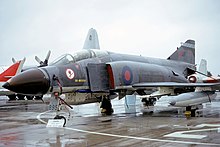
Spey-enginedPhantoms(the plane the government eventually bought, having been ordered in February 1964 for the Fleet Air Arm, instead of the P.1154) were chosen in 1966 for the station's future as with the scrapping of aircraft carriers the Phantoms were not needed for the Fleet Air Arm,[10]with all RAF Phantom training taking place on the airfield, and the station became part ofFighter Command[10]until December 1967, when it joinedAir Support Commandas the Phantoms were initially in a ground attack role. Phantoms first saw operational service with the Fleet Air Arm in 1970. The firstPhantom FGR2(Fighter/Ground attack/Reconnaissance) arrived at Coningsby on 23 August 1968, with the first aircrewOCUcourse (No. 228 OCU) beginning in October 1968. Air-defence Phantoms (FG1) also entered service in 1969 at RAF Leuchars. On 18 May 1970, a Phantom flew from the base non-stop toRAF Tengahin Singapore, covering 8,680 mi (13,970 km) in 14 hours and 14 minutes at an average speed of 602 mph (969 km/h). In April 1968,RAF Strike Commandwas formed and the airfield was transferred toNo. 38 Group.[15]
No. 41(F) Squadronjoined in April 1972, and stayed until 1977. The other ground-attack Phantom squadrons (four of them) were atRAF Bruggen.No. 111(F) Squadronreplaced their Lightnings (fromRAF Wattisham) with Phantoms from 1 October 1974. On 1 January 1975,No. 29(F) Squadronjoined and stayed until 1987, when disbanded. On 1 November 1975,No. 23(F) Squadronjoined until February 1976, when moved to RAF Wattisham. In March 1976,No. 56(F) Squadronjoined until July 1976, then went to Wattisham.[16]
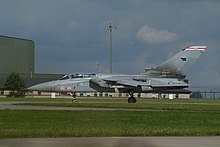
The Phantom's role changed to air defence in October 1974 when the airfield transferred toNo. 11 Groupin Strike Command, when theSEPECAT Jaguar(situated in Norfolk) took over the ground attack role. No. 111(F) Squadron were the first to take the new air defence Phantoms. During 1975, the UK's air defence transferred to the Phantom FGR.2 from five squadrons ofEnglish Electric Lightnings.The UK was covered by NATO Early Warning Area 12. Three Sector Operations Centres were atRAF Buchan,BoulmerandNeatishead;in the 1960s, the UK had theLinesman/Mediatorradar system, which was obsolete by the 1970s. No. 29(F) Squadron formed with Phantoms at Coningsby on 1 January 1975; until then the Phantom FG.1 had been operating with the Royal Navy only. On 3 March 1975, a Phantom crashed into a nearby house, with both pilot and navigator ejecting. The Queen visited the station on 30 June 1976.[17]
Tornados
[edit]Panavia Tornado F3squadrons began to form from November 1984, namelyNo. 229 OCU/No. 65 Squadron.[18]Tornado training took place until April 1987, when the Phantoms left (to RAF Leuchars) and Coningsby had the first (No. 29(F) Squadron) Tornado air defence squadron.[19][20]
To accommodate these new aircraft, extensivehardened aircraft shelters(HAS) and support facilities were built.[18]No. 5 Squadronarrived in January 1988, having previously operated the English Electric Lightning.[21]
Exercise Priory took place in October 1985.[22]
During theGulf War,Tornados from Coningsby were based for three months atDhahran International Airportto participate inOperation Granby.Tornado engines were serviced on the northern section of the formerRAF Woodhall Spa,denoted as RAF Woodhall.[23][24]
Jaguars
[edit]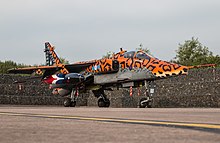
With the running down ofRAF Coltishallin Norfolk, No. 6 Squadron relocated with their SEPECAT Jaguars to Coningsby on 1 April 2006, where it was planned they would operate from until October 2007.[25]However, on 25 April 2007 it was announced by theMinistry of Defencethat the Jaguars would be withdrawn from service on 30 April.[26]May 2007 saw No. 6 Squadron flying their Jaguars toRAF Cosfordwhere they would be utilised byNo. 1 SoTT.[27]No. 6 Squadron disbanded on 31 May 2007.[28]Deliveries continued in June and July, with the last Jaguar to arrive at Cosford from Coningsby beingXX119on 2 July 2007.[25]
Eurofighter Typhoon
[edit]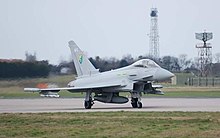
Coningsby was the first airfield to receive the Phantoms,[10]the Tornado ADV[10]and was the first to receive its replacement, the Eurofighter Typhoon. Typhoon arrived in May 2005 withNo. 17 Squadron,after the RAF first publicly displayed the aircraft at Coningsby in December 2004.[29]No. 3(F) Squadronmoved to RAF Coningsby where it became the first operational front line RAF Typhoon squadron in July 2007[30]andNo. 11(F) Squadronbecame operational at RAF Coningsby shortly thereafter.[31]
No. 12 Squadronreactivated in July 2018 and is temporarily integratingQatar Emiri Air Forceair and ground crews in order to provide training and support as part of the Qatari purchase of twenty-four Typhoons from the UK.[32]
In October 2019, RAF Coningsby signed a twinning agreement withFighter Wing 73(Jagdgeschwader 73) of theGerman Air Force(Luftwaffe) to enhance opportunities to meet and train with one another. The wing, based atLaagein north-eastern Germany, also operates the Eurofighter Typhoon.[33]
Role and operations
[edit]RAF Coningsby's mission statement is 'To develop the future, deliver the present and commemorate the past of the Royal Air Force's combat air power.'[34]The station is home to nearly 3,000 military personnel, civil servants, and contractors.[35]BAE Systems Military Air Solutions,who produce the Typhoon, are also stationed on the airfield with the contract to maintain the aircraft.[36]
Command
[edit]The station commander isGroup CaptainBilly Cooper.[37]William, Prince of Walesserved as the station'sHonorary Air Commandantfrom 2008 till 2023.[38]His wife,Catherine,took over the role in August 2023.[39]The station is under the command ofNo. 1 Group (Air Combat).[40]
Typhoon operations
[edit]
TheEurofighter TyphoonFGR4provides the RAF with a multi-role combat capability for air policing, peace support and high intensity conflict. RAF Coningsby is the home to three front-line Typhoon units,No. 3(F) SquadronandNo. 11 Squadronas well asNo. 12 Squadronwhich is a joint RAF/Qatar Emiri Air Forcesquadron. They are accompanied byNo. 29 Squadronwhich is the Typhoon Operational Conversion Unit which trains new crews.[41]
Quick Reaction Alert
[edit]Since June 2007, Coningsby's Typhoons have been responsible for maintaining theQuick Reaction Alert (Interceptor) South mission (QRA(I)S).Aircraft and crews are held at a high state of readiness, 24 hours a day, 365 days a year, to respond to unidentified aircraft approaching UK airspace. QRA missions range from civilian airliners which have stopped responding to air traffic control, to intercepting Russian aircraft such as theTupolev Tu-95 BearandTu-160 Blackjack.[42]
Test and Evaluation
[edit]The fourth Typhoon unit isNo. 41 (Test and Evaluation) Squadronwhich is part of theAir Warfare Centre.The squadron develops operational tactics and evaluates new avionics and weapons systems. Formerly the Fast Jet and Weapons Operational Evaluation Unit (FJWOEU), which was formed by merging theStrike Attack OEU(previously based atMOD Boscombe Down) and the Tornado F3 OEU (now returned back to its home base of RAF Coningsby[43]after a temporary 'lay-over' atRAF Waddington) and the Air-Guided Weapons OEU (previously based atRAF Valley).[44]
Battle of Britain Memorial Flight
[edit]
Coningsby has been home of theBattle of Britain Memorial Flight(BBMF) and the associated visitor centre since March 1976 when it arrived fromRAF Coltishall.[10][45]The BBMF operate one of two remaining airworthyAvro Lancasterbombers in the world, alongside; sixSpitfiresof various types; twoHurricanes;aDakotaand twoChipmunks,the latter type being used for pilot training.[46]
Force Protection
[edit]No. 7 Force Protection Wing Headquarters provides operational planning, command and control to twoRAF Regimentfield squadrons attached to the wing,No. 63 (Queen's Colour) Squadron(based atRAF Northolt) andNo. 2623 (East Anglian) Squadron (RAuxAF)(based atRAF Honington) whose purpose is to protect RAF bases at home and abroad from ground attack.[47]Part of No. 4RAF PoliceSquadron, under the command of No. 2 RAF Police & Security Wing atRAF Waddington,is also based at the station and provides policing, security and guarding.[48]
Air Land Integration (ALI) Cell
[edit]No. 7 Force Protection Wing includes the Air Land Integration (ALI) Cell, which provides aforward air controlcapability. The ALI Cell trains and providesJoint Terminal Attack Controllers(JTACS) andTactical Air Controller Parties(TACPS) to support RAF and joint operations. The ALI Cell moved to Coningsby from RAF Honington in Suffolk and came under the control off the wing in June 2018.[49]
Expeditionary Air Wing
[edit]No. 121 Expeditionary Air Wingwas formed at Coningsby on 1 April 2006 to create a deployable air force structure.[50][51]
Based units
[edit]
Flying and major non-flying units based at RAF Coningsby.[52][53]
Royal Air Force
[edit]- Combat Air Force
- Headquarters, Combat Air Force[54]
- No. 3 (Fighter) Squadron–Typhoon FGR4
- No. 11 (F) Squadron– Typhoon FGR4
- No. 12 Squadron– Typhoon FGR4
- No. 29 Squadron– Typhoon FGR4
- Typhoon Display Team
- Air and Space Warfare Centre
- No. 41 Test and Evaluation Squadron– Typhoon FGR4
- Battle of Britain Memorial Flight (BBMF)–Spitfire,Hurricane,Lancaster,DakotaandChipmunk
No. 2 Group (Air Combat Support)
- Air Security Force
- No. 2 RAF Police & Security Wing
- Combat and Readiness Force
- No. 7 Force Protection Wing
- Headquarters No. 7 Force Protection Wing
- Air Land Integration (ALI) Cell
- No. 7 Force Protection Wing
British Army
[edit]- 8 Engineer Brigade
- 170 (Infrastructure Support) Engineer Group
- 20 Works Group (Air Support)
- 532 Specialist Team Royal Engineers (Airfields) (STRE)
- 20 Works Group (Air Support)
- 170 (Infrastructure Support) Engineer Group
Heritage
[edit]Station badge and motto
[edit]RAF Coningsby'sbadge,awarded in December 1958, features a depiction ofTattershall Castle.The local landmark, dating from the 15th century, is about 1 kilometre (0.62 mi) north-west of the station.[55]
The station'smottoisLoyalty binds me.[55]
Gate guardians
[edit]Two preserved aircraft are located at the main gate of RAF Coningsby and act asgate guardiansfor the station. The first isMcDonnell Douglas F-4M Phantom FGR.2'XT891'wearing No. 41 Squadron markings and the secondPanavia Tornado F3'ZE760'inNo.5 Squadronmarkings.[56][57]
Within the No. 3 Squadronhardened aircraft shelter(HAS) complex,Hawker Siddeley Harrier GR.3'XW924' is on display and within the No.11 Squadron HAS complex isEnglish Electric Lightning F.6'XT753'.A further Lightning F.6, 'XS897' (wearing 'XP765') is preserved in the No. 29 Squadron site.[56]
Incidents and accidents
[edit]1974 Norfolk mid-air collision:On 9 August 1974, the station commander 42-year-old Group Captain David Blucke, and his navigatorFlight LieutenantTerence Kirkland (aged 28 and fromDerry), were killed whilst piloting the Phantom XV493 of41 Squadron.Flying at low level, it hit aPiper Pawneecrop-spraying plane (fromSouthend-on-Sea) overFordham, Norfolk,nearDownham Market.Blucke was son of Air Vice-MarshalRobert Bluckewho was known for the 1935Daventry Experiment.[58]
2024 Spitfire crash: On 25 May 2024, Supermarine Spitfire LF Mk.IXeMK356of the Battle of Britain Memorial Flight crashed shortly after takeoff in a field off Langrick Road, to the east of the station.[59][60]The sole pilot, Squadron Leader Mark Long, was killed in the accident.[61]He had been a pilot with the team for four years, and was set to become Officer Commanding BBMF in October 2024.[61][62]Along with a BBMF Hawker Hurricane, the aircraft was due to display at theLincolnshire Aviation Heritage CentreinEast Kirkby,Lincolnshire as a part of the centre's "Lanc, Tank and Military Machines" event.[63][64]
List of Station Commanders
[edit]
- Air Chief MarshalSirAugustus WalkerGCB1951–1954
- Air CommodoreDavid StrongCB1957–59
- Air Vice-MarshalMichael Le Bas CBCBEDSO AFC 1959–1961
- Air Vice-Marshal Frank Dodd CBEDFC1961–1963
- Air Chief MarshalSir John RogersKCB CBE 1967–1969
- Group Captain David Robert Kidgell Blucke?-1974
- Air Vice-Marshal Dennis Allison CB 1974–1976
- Air Vice-MarshalDerek BryantCB OBE 1976–1978
- Group CaptainChristopher Sprent 1978–80
- Air Chief MarshalSir William WrattenCBE CB 1980–1982
- Air Commodore Robert (Bob) Arnott CBE 1982–1984
- Group Captain Mike Elsam 1984–1986
- Air MarshalSir Christopher CovilleCB 1986–1988
- Air CommodoreMartin Widdowson1988–1990
- Air MarshalClifford SpinkCB CBE 1990–1993
- Air Vice-Marshal Peter Ruddock CBE 1999–2000
The following Station Commanders are listed in the rank held at the time of appointment:
- Group CaptainBob Judson(2004–2006)
- Group CaptainStuart AthaDSO(2006–2008)
- Group Captain J J Hitchcock (2008–2010)
- Group CaptainMartin SampsonDSO(2010–2012)
- Group CaptainJohnny Stringer(2012–2014)
- Group Captain Jez AttridgeOBE(2014–2016)
- Group Captain Mike Baulkwill (2016–2018)
- Group Captain Mark Flewin (2018–2020)[65]
- Group Captain Matt Peterson (2020–2022)[66]
- Group Captain Billy Cooper (2022–2024)[37]
- Group Captain Paul O’Grady (2024–present)[67]
See also
[edit]References
[edit]Citations
[edit]- ^Pine, L.G. (1983).A dictionary of mottoes(1 ed.). London: Routledge & Kegan Paul. p.131.ISBN0-7100-9339-X.
- ^"Defence Estates Development Plan 2009 – Annex A".GOV.UK.Ministry of Defence. 3 July 2009. p. 18.Retrieved3 March2019.
- ^"RAF Coningsby Defence Aerodrome Manual"(PDF).Royal Air Force.Military Aviation Authority.29 June 2017.Retrieved3 March2019.
- ^abc"Bomber Command – Coningsby".Royal Air Force Bomber Command 60th Anniversary.6 April 2005. Archived fromthe originalon 6 April 2011.Retrieved17 March2019.
- ^abcdMarriott 1997,p. 76.
- ^abHalpenny, Bruce BarrymoreAction Stations: Wartime Military Airfields of Lincolnshire and the East Midlands v. 2,page 64
- ^abc"History – WWII to Phantoms".RAF Coningsby.Archived fromthe originalon 22 July 2015.Retrieved17 March2019.
- ^Halpenny, Bruce BarrymoreAction Stations: Wartime Military Airfields of Lincolnshire and the East Midlands v. 2.Page?
- ^Grounds, Eric (2015).The Quiet Australian: The story of Teddy Hudleston, the RAF's troubleshooter for 20 years.Mereo Books.ISBN978-1861514783.
- ^abcdefghiHalpenny, Bruce BarrymoreAction Stations: Wartime Military Airfields of Lincolnshire and the East Midlands v. 2.Page 67.
- ^McLelland, Tim (2010).TSR2: Britain's Lost Cold War Strike Aircraft.Ian Allan. p. 115.ISBN978-1-906537-19-7.
- ^"DEFENCE (Hansard, 4 March 1968)".api.parliament.uk.
- ^Wood 1975, p. 224.
- ^"F.111 Aircraft (Hansard, 13 December 1965)".api.parliament.uk.
- ^Darling, p. 91
- ^"56 Squadron History".56 Squadron – Home of the Firebirds.Retrieved6 December2018.
- ^"The Queen Leaves For Raf Coningsby".Shutterstock.Retrieved4 July2019.
- ^abHalpenny, Bruce BarrymoreAction Stations: Wartime Military Airfields of Lincolnshire and the East Midlands v. 2.Page 221.
- ^Halpenny, Bruce BarrymoreAction Stations: Wartime Military Airfields of Lincolnshire and the East Midlands v. 2.Page 222.
- ^"Central News East: 20.11.1986: Top Gun Pilots".MACE Archive.23 June 2017.
- ^"History".Tornado Data.Retrieved4 July2017.
- ^"Central News East: 22.10.1985: RAF Exercise Priory".MACE Archive.23 June 2017.
- ^Historic England."RAF Woodhall Spa, Tattershall Thorpe (1432038)".Research records (formerly PastScape).Retrieved28 May2013.
- ^"Thorpe Camp".Retrieved28 May2013.
- ^ab"SEPECAT Jaguar – History".Thunder and Lightnings.Retrieved15 October2021.
- ^Dennis, Andrew (20 February 2019)."Jaguar: The Accidental Cold War Warrior".Royal Air Force Museum.Retrieved15 October2021.
- ^"The End of Jaguar Operations, RAF Coningsby".Target Aviation Photography.Retrieved15 October2021.
- ^"2003 – 2007".6 Squadron Association.13 January 2017.Retrieved15 October2021.
- ^"BAE Systems bids farewell to 17(R) Sqn as they head for new home at RAF Coningsby".BAE Systems plc. 1 April 2005. Archived fromthe originalon 11 March 2006.Retrieved17 October2006.
- ^"Typhoon Goes Operational".Ministry of Defence. 11 July 2007.Retrieved7 June2019.
- ^RAF Coningsby squadronsretrieved 29 December 2008
- ^"Joint UK-Qatari Typhoon squadron stands up as defence relationship deepens".GOV.UK.Ministry of Defence. 24 July 2018.Retrieved24 July2018.
- ^"RAF Coningsby Twinned with German Eurofighter Wing".Royal Air Force.17 October 2019.Retrieved22 October2019.
- ^"About us".RAF Coningsby.Archived fromthe originalon 3 July 2017.Retrieved4 March2019.
- ^"RAF Coningsby – The Station".Royal Air Force.Retrieved4 March2019.
- ^"Eurofighter contract secures jobs".BBC. 4 March 2009.Retrieved4 July2019.
- ^ab"Station Commander Handover".Royal Air Force.7 October 2022.Retrieved17 April2023.
- ^"RAF Regiment Association Official Site".Rafregt.org.uk. Archived fromthe originalon 2 February 2009.Retrieved15 October2008.
- ^"Further Military Appointments for Members of the Royal Family".The Royal Family.11 August 2023.Retrieved11 August2023.
- ^"No 1 Group".Royal Air Force.Retrieved17 March2019.
- ^"RAF Coningsby".Royal Air Force.Retrieved16 September2020.
- ^"RAF Coningsby: At the Cutting Edge of the Typhoon Force".Forces.net. 17 April 2019.Retrieved4 July2019.
- ^"41 Squadron".Royal Air Force. Archived fromthe originalon 14 January 2011.Retrieved22 March2019.
- ^"Eurofighter Typhoon enhancement programme: our crucial role".Qinetiq. 19 January 2018.Retrieved29 June2019.
- ^"Battle of Britain Memorial Flight - Royal Air Force".Battle of Britain Memorial Flight.
- ^"Prince William takes to skies at Battle of Britain memorial".BBC. 22 September 2015.Retrieved4 July2017.
- ^"Force Protection".Royal Air Force.Retrieved20 October2018.
- ^"4 RAF Police (Typhoon) Squadron".Royal Air Force.Retrieved18 April2023.
- ^"Air Land Integration (ALI) Cell"(PDF).One to One - the RAF Coningsby Journal(2): 7. 2018.
- ^Cotter 2008, p. 33.
- ^"121 Expeditionary Air Wing Training".Royal Air Force.17 September 2015. Archived fromthe originalon 1 January 2018.Retrieved16 July2017.
- ^"RAF Coningsby – Who's Based Here".Royal Air Force.Retrieved18 April2023.
- ^"An introduction to...20 Works Group Royal Engineers"(PDF).Wittering View.Lance Publishing Ltd.: 18 Spring 2015.
- ^"FOI(A) regarding current RAF 'Forces'"(PDF).What do they know?.14 June 2021.Retrieved14 June2021.
- ^ab"RAF Coningsby".RAF Heraldry Trust.Retrieved17 March2019.
- ^ab"RAF Coningsby, Lincolnshire".Demobbed - Out of Service British Military Aircraft.February 2019.Retrieved17 March2019.
- ^"Preserved Aircraft Information".Bomber County Aviation Resource.Retrieved17 March2019.
- ^"Collision over Norfolk".Flight International.106(3413). IPC Transport Press Ltd: 146. 15 August 1974.
- ^"Spitfire crash: Tributes to pilot killed at Coningsby".BBC News.26 May 2024.
- ^"Squadron Leader Mark Long | RAF Memorial Flight Club".www.memorialflightclub.com.Retrieved27 May2024.
- ^ab"STATEMENT BY GROUP CAPTAIN ROBBIE LEES, COMMANDER DISPLAY AIR WING".Royal Air Force.26 May 2024.Retrieved26 May2024.
- ^"Future Officer Commanding BBMF selected".RAF Memorial Flight Club.Retrieved26 May2024.
- ^"Displays | Battle of Britain Memorial Flight".Royal Air Force.Archivedfrom the original on 26 May 2024.Retrieved26 May2024.
- ^"Lanc, Tank and Military Machines 25th May".Lincolnshire Aviation Heritage Centre.Archivedfrom the original on 26 May 2024.Retrieved26 May2024.
- ^"RAF Coningsby Welcomes New Station Commander".Forces Network.18 October 2018.Retrieved17 March2019.
- ^"Group Captain Matt Peterson in command at RAF Coningsby",Horncastle News,7 May 2020,retrieved4 October2020
- ^"New Station Commander at Royal Air Force Coningsby".Royal Air Force.5 February 2024.Retrieved25 May2024.
Bibliography
[edit]- Cotter, Jarrod (2008).Royal Air Force celebrating 90 years.Stamford,UK: Key Publishing Ltd.ISBN978-0-946219-11-7.
- Darling, Kev (2012).RAF Strike Command, 1968-2007: Aircraft, Men and Action.Pen & Sword.ISBN978-1848848986.
- Bruce Barrymore Halpenny(1991)Action Stations: Wartime Military Airfields of Lincolnshire and the East Midlands v. 2,Patrick Stephens,ISBN978-1852604059
- Marriott, Leo (1997).British Military Airfields – Then and Now.Shepperton, Surrey: Ian Allan Publishing.ISBN978-0-7110-2515-8.
- Wood, Derek (1975).Project Cancelled.London: Macdonald and Jane's.ISBN0-356-85109-5.


